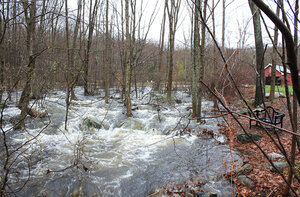A deluge of rain causes renovation problems
New England's record-breaking rains have caused problems for the renovation of Sheep Dog Hollow and at Little Pug.

The normally gentle babbling brook behind Alexandra Marks's current home, "Little Pug," has expanded quite a bit in the last two days due to the record-breaking rainstorms that have swept New England.
Courtesy of Alexandra Marks
Ah, nature. As I understand the whole idea of going “green,” it's to work in conjunction with nature, to protect and preserve its resourceful beauty as we meet our own needs.
That’s the idea behind Sheep Dog Hollow, the lovely old farmhouse at the heart of our green renovation experiment. It sits amid bucolic fields bordered by old stone walls and streams, with a pond or two dotting the landscape.
It reminds me of my grandparents farm, Lone Jack, in the Piedmont region of Virginia. My uncle and cousins are doing their best to protect and preserve Lone Jack for future generations.
And so, as a part of the Northern contingent of the family, I figured I could do the same for Sheep Dog Hollow – although, not on quite as grand a scale.
But what do you do when eight inches of rain – about a month’s worth - is dumped on you in a mere 48 hour period? Well, you make do and you learn even more about construction and home renovation.
During all the rain, the carpenters were only able to work inside or in porch-protected areas – and that put us behind a bit.
Then, of course, there was the roof. It’s cedar and it got wet – very wet. But that’s what cedar roofs do, according to our roofers. It will dry out, just like the wood in the forests, and it will be fine – once the buckling is addressed.
Yes, after the roof was installed this winter, the cedar shakes started to buckle. Our roofers think it was because the cedar wasn’t as green as it should have been when they nailed it onto those furring strips.
They’ve assured us that once the sun gets warm and dries the roof out completely, they will fix the buckles by shaving down the offending shakes and doing whatever else needs to be done to ensure that the roof lasts a good 30 years.
OK, I was fine with that. It’s a local company with a good reputation. But during our recent deluge, water started dripping down from the chimneys – which were flashed to protect against such eventualities.
Our building inspector happened to come by to do a framing inspection on Tuesday. He saw that water seeping in and said it had to be addressed.
So I again called our roofers. As it turned out, I was one of several hundred customers calling that morning. The water seeping in, I was assured, had nothing to do with the flashing. It had to do with the brick and mortar.
“There’s so much water, it's soaking into the concrete, and that’s what’s causing the seepage. The flashing is fine,” said the owner (whose name I’m not using because I don’t want to give the company an unwarranted bad rap. They’ve assured me they’ll address all our issues.) “I’ve gotten 200 calls this morning about the same thing. There’s just been too much rain.”
He finally agreed to send someone out to check out the flashing and the state of the buckling.
Fortunately, though, our newly reinforced basement at Sheep Dog was dry as a bone. For that I thank the work that was done by our foundation guys.
But I can’t say the same about our current home, Little Pug Farmette. In common with thousands of other homes in Connecticut, Rhode Island, and Massachusetts, our basement flooded.
This is only the second time since I’ve owned the place that it’s gotten wet down there. The first time was after I’d just bought it. The former owner had neglected to tell me there was a sump pump in the basement that had to be plugged in. Since then, we’ve had no problems.
When I first went downstairs and saw the water around the boiler on Tuesday, I thought that our hot water tank had burst. I was wrong.
Unfortunately, this record-setting rain was too much for our sump pump, which hasn’t stopped working since Monday morning. Nonetheless, water has seeped into the basement.
When I realized it wasn’t the boiler or water tank that burst on Tuesday, I got down there with a wet vacuum and a bucket. That’s how I spent Wednesday as well. Every time I’d get several inches of water up and saw dry concrete, the water would seep back in within an hour or two. Call me Sysiphus.
The ground is so saturated here that water seeped in every which way it could. Fortunately, my wet-vac vigilance has kept the water level to one or two inches, rather than feet, and the damage to a minimum.
I managed to get all of the furniture up on blocks and my grandmother's Oriental rug safely off the floor before the water spread to the finished part of the basement.
But the water eventually did seep across the whole floor. So, now I’ve got to get back to my wet vac. Events like these have a wonderfully humbling impact on rational people like me who think that mankind is in control of things.
Alexandra Marks blogs twice a week about her green and budget-friendly restoration of a 1902 farmhouse in Connecticut. Click here to find all her blog posts and articles.
